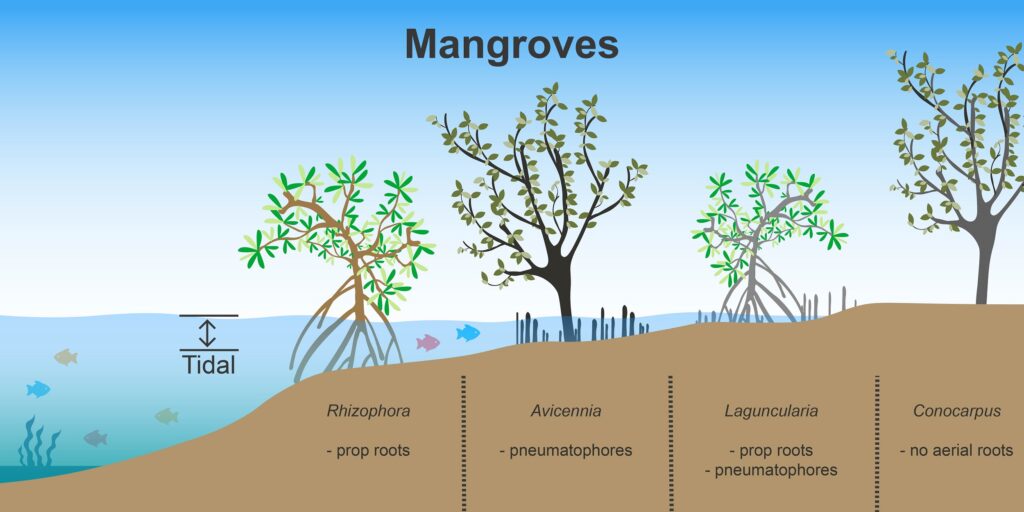Types of mangrove
Today we are talking about types or species of mangroves that are found in various regions around the world.
INTRODUCTION:
Mangroves are unique and highly adaptable ecosystems found in tropical and subtropical regions along coastlines, where land and sea meet. They consist of various species of trees and shrubs that have adapted to survive in brackish water, characterized by high salt content and tidal influences.

Ecology and uses of mangroves:
Ecology:
| Category | Description |
|---|---|
| Biodiversity | Mangroves support a diverse range of flora and fauna, including specialized mangrove trees, various fish species, crustaceans, birds, and mammals. |
| Coastal Protection | Mangrove forests act as natural buffers against storms, waves, and coastal erosion, reducing the impact of natural disasters. |
| Habitat and Nursery | Mangroves serve as important habitats and nurseries for many marine organisms, providing shelter, breeding grounds, and food sources. |
| Carbon Sink | Mangroves sequester and store significant amounts of carbon dioxide, playing a vital role in mitigating climate change. |
| Water Filtration | Mangroves help filter and trap sediments, pollutants, and excess nutrients, improving water quality and promoting ecosystem health. |

Uses:
| Category | Description |
|---|---|
| Wood and Timber | Mangrove wood is utilized in construction, boat building, and furniture due to its strength, durability, and resistance to decay. |
| Fisheries | Mangrove ecosystems support valuable fish and shellfish populations, providing livelihoods for local communities through fishing and aquaculture. |
| Coastal Tourism | Mangrove forests attract tourists for their scenic beauty, biodiversity, and recreational activities like boating, kayaking, and bird watching. |
| Medicinal Purposes | Traditional medicine incorporates various mangrove plants for their medicinal properties, including treatments for ailments like dysentery and skin infections. |
| Economic Benefits | Mangroves contribute to local economies through ecotourism, carbon offset projects, and sustainable harvesting of forest products. |

Types of mangroves:
There are several types or species of mangroves:
- Red Mangrove (Rhizophora mangle):

2. Black Mangrove (Avicennia germinans):

3. White Mangrove (Laguncularia racemosa):

4. Buttonwood Mangrove (Conocarpus erectus):

5. Sonneratia Mangroves (Sonneratia alba, Sonneratia caseolaris, Sonneratia ovata):

6. Mangrove Palm (Nypa fruticans):

The top five largest mangrove forests in the world:
Along with the dominant mangrove species found in each, are:
- Sundarbans – Bangladesh and India: Dominant Mangrove Species: Sundari (Heritiera fomes), Gewa (Excoecaria agallocha), Keora (Sonneratia apetala), and others.

2. Marismas Nacionales – Mexico: Dominant Mangrove Species: Red Mangrove (Rhizophora mangle), Black Mangrove (Avicennia germinans), White Mangrove (Laguncularia racemosa), and others.

3. Bhitarkanika Mangroves – India: Dominant Mangrove Species: Sundari (Heritiera fomes), Gewa (Excoecaria agallocha), Dhani (Ceriops decandra), and others.

4. Amazon River Delta – Brazil: Dominant Mangrove Species: Red Mangrove (Rhizophora mangle), Black Mangrove (Avicennia germinans), White Mangrove (Laguncularia racemosa), and others.

5. Gulf of Fonseca – Honduras, El Salvador, and Nicaragua:
Dominant Mangrove Species: Red Mangrove (Rhizophora mangle), Black Mangrove (Avicennia germinans), White Mangrove (Laguncularia racemosa), and others.

3 thoughts on “Types of mangrove”
That’s certainly compelling. May I pose a few questions?
sure
This makes better sense than other people…